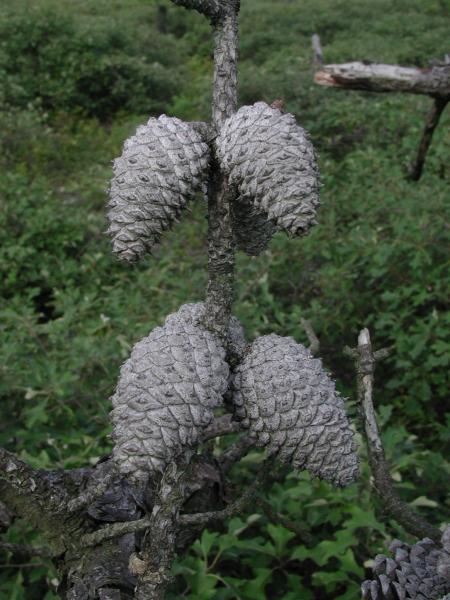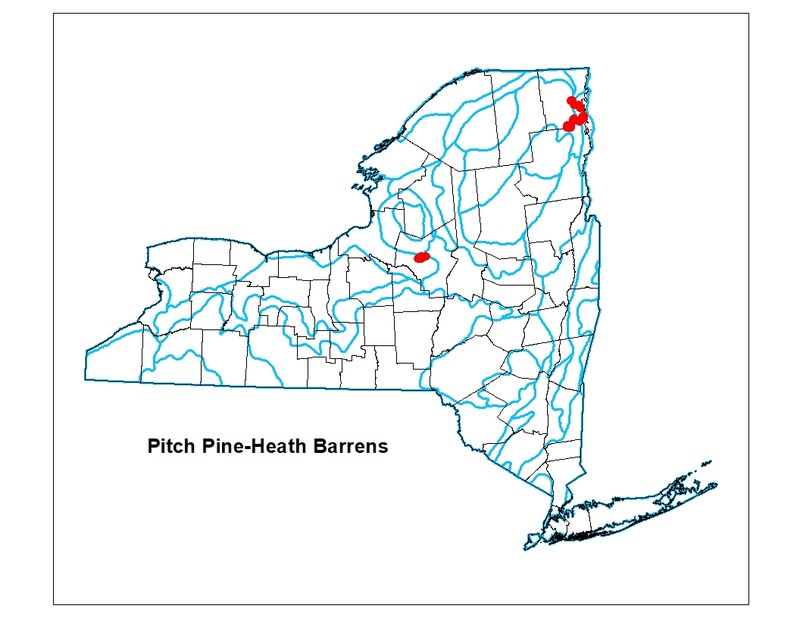Pitch Pine-Heath Barrens
- System
- Terrestrial
- Subsystem
- Barrens And Woodlands
- State Protection
- Not Listed
Not listed or protected by New York State.
- Federal Protection
- Not Listed
- State Conservation Status Rank
- S1S2
Critically Imperiled or Imperiled in New York - Especially or very vulnerable to disappearing from New York due to rarity or other factors; typically 20 or fewer populations or locations in New York, very few individuals, very restricted range, few remaining acres (or miles of stream), and/or steep declines. More information is needed to assign either S1 or S2.
- Global Conservation Status Rank
- G4
Apparently Secure globally - Uncommon in the world but not rare; usually widespread, but may be rare in some parts of its range; possibly some cause for long-term concern due to declines or other factors.
Summary
Did you know?
In the absence of fire, which may be required to maintain this community, pitch pine-heath barrens seem to naturally succeed to pitch pine-oak forest and pine-northern hardwood forest communities. The barrens may have been burned somewhat regularly by early settlers to maintain blueberry crops.
State Ranking Justification
This is a relatively uncommon natural community with an estimated 15 to 30 extant occurrences statewide. A few documented occurrences have good viability and are protected on public land or private conservation land. This community has a limited statewide distribution (correlated to old lake deltas and outwash plains in the Adirondacks). Although there are a few occurrences over 450 acres in size, most are around 100 acres or less. Threats to this community include fire suppression, fragmenting development, recreational overuse, habitat alteration, and to a lesser extent invasive species.
Short-term Trends
The number and acreage of pitch pine-heath barrens in New York have probably declined slightly in recent decades due to fire suppression, disturbance by off-road vehicles, and development.
Long-term Trends
The number and acreage of pitch pine-heath barrens in New York have probably had substantial declines from historical numbers due to fire suppression, fragmentation, disturbance by off-road vehicles, and development.
Conservation and Management
Threats
As a fire-dependent natural community, the primary threat to pitch pine-heath barrens is the suppression of fire. Other threats to this community include fragmenting development (e.g., residential, roads, utility ROWs, trails), recreational overuse (e.g., ATV use, trampling/off trail hiking), and habitat alteration (e.g., sand and gravel mining, excessive logging, trash dumping). Although not currently considered a major threat, invasive species, such as forked three-awned grass (Aritida basiramea), may become a problem at some sites in the future. Southern pine beetle (Dendroctonus frontalis) is a bark beetle that infests pine trees, such as pitch pine, white pine, and red pine. Southern pine beetle is native to the southeastern United States, but its range has spread up the east coast to Long Island, New York in 2014. Natural communities dominated or co-dominated by pines would likely be most impacted by southern pine beetle invasion.
Conservation Strategies and Management Practices
Develop and implement prescribed burn plans at appropriate sites. Reduce or minimize fragmenting features, such as residential and commercial development, roads, abandoned clearings, unnecessary trails, etc. Restrict mountain bikes and ATVs to designated trails and least sensitive areas, and prevent dumping of trash. Remove or control invasive species where appropriate.
Development and Mitigation Considerations
The soils are acidic and nutrient poor. Any soil enrichment contamination (e.g., from septic leach fields and fertilized lawns) in or around the barrens may alter its community structure and function. The open structure of this community is often maintained by fire and can present a fire hazard to existing and proposed development. Unprotected structures located within or near this community are more susceptible to damage from fire.
Inventory Needs
Inventory all existing occurrences with records greater than ten years old. Continue searching for large sites in northern New York sandplains that are in good condition (A- to AB-ranked). Need critical assessment of identity for several occurrences using statistical ordination techniques, in order to clearly separate pitch pine-heath barrens from boreal heath barrens and from the successional bleuberry heath community.
Research Needs
Determine the optimal fire regime for this community. This community needs to be compared to heath barrens in other states (e.g., Maine or Michigan) and in Canada to evaluate quality and composition in a regional context.
Rare Species
- Callophrys irus (Frosted Elfin) (guide)
- Carex houghtoniana (Houghton's Sedge) (guide)
- Ceanothus herbaceus (Prairie Redroot) (guide)
- Cyperus schweinitzii (Schweinitz's Flat Sedge) (guide)
- Datana ranaeceps (A Hand-maid Moth) (guide)
- Desmodium ciliare (Hairy Small-leaved Tick Trefoil) (guide)
- Digitaria filiformis (Slender Crab Grass) (guide)
- Eurybia spectabilis (Showy Aster) (guide)
- Lespedeza stuevei (Stuve's Bush Clover) (guide)
- Lygodium palmatum (Climbing Fern) (guide)
- Malaxis bayardii (Bayard's Adder's Mouth Orchid) (guide)
- Myotis septentrionalis (Northern Long-eared Bat) (guide)
- Platanthera ciliaris (Orange Fringed Orchid) (guide)
- Platanthera cristata (Orange Crested Orchid) (guide)
- Rhododendron canadense (Rhodora) (guide)
- Sericocarpus linifolius (Narrow-leaved White-topped Aster) (guide)
- Symphyotrichum concolor var. concolor (Eastern Silvery Aster) (guide)
- Zanclognatha martha (Pine Barrens Zanclognatha) (guide)
Range
New York State Distribution
Scattered within northern and north-central New York in the northeastern portions of the Great Lakes Ecoregion and adjacent parts of other ecoregions, where it is apparently restricted to sandplains. Currently known only from the Champlain Valley of Clinton County and Erie-Ontario Plain of Oneida County. New York is near the southeastern edge of range extending north into Canada and Maine, and west to northern Michigan and Wisconsin.
Global Distribution
This community is apparently restricted to sandplains in the Great Lakes basin. Assuming that jack pine barrens should be lumped into the community concept, the range spans north to Canada, east to Maine, west to northern Michigan and Wisconsin, and south to New York. The more restricted pitch pine-dominated barrens are probably restricted to southern Ontario, northern New York and Vermont, and possibly New Hampshire and Maine.
Best Places to See
- Clintonville Pine Barrens
- Rome Sand Plains (Oneida County)
Identification Comments
General Description
This shrub-savanna community occurs on well-drained, sandy or rocky soils. The most abundant tree is pitch pine (Pinus rigida); in some stands there is an admixture of one or more species including big tooth aspen (Populus grandidentata), white pine (Pinus strobus), or jack pine (P. banksiana). The percent cover of trees is variable, ranging from 30 to 60%. The shrublayer is dominated by heath shrubs such as black huckleberry (Gaylussacia baccata), blueberries (Vaccinium angustifolium, V. pallidum, and V. myrtilloides), and sheep-laurel (Kalmia angustifolia), as well as sweet-fern (Comptonia peregrina). This shrublayer may be quite diverse. Characteristic groundlayer species include wintergreen (Gaultheria procumbens), wild sarsaparilla (Aralia nudicaulis), Canada mayflower (Maianthemum canadense), cow-wheat (Melampyrum lineare), wild strawberry (Fragaria virginiana), moccasin flower (Cypripedium acaule), Pennsylvania sedge (Carex pensylvanica), and bracken fern (Pteridium aquilinum). Characteristic birds include ovenbird (Seiurus aurocapillus), veery (Catharus fuscescens), common yellowthroat (Geothlypis trichas), chestnut-sided warbler (Dendroica pensylvanica), and wood thrush (Hylocichla mustelina).
Characters Most Useful for Identification
This pitch pine-heath barrens community is structurally intermediate between a forested and an open upland community. It has a sparse tree canopy and a moderately dense shrub layer. There are scattered herb-dominated savannah openings throughout.
Elevation Range
Known examples of this community have been found at elevations between 100 feet and 761 feet.
Best Time to See
During midsummer, two species of lowbush blueberry come into fruit, producing a tasty snack.
Pitch Pine-Heath Barrens Images
Classification
International Vegetation Classification Associations
This New York natural community encompasses all or part of the concept of the following International Vegetation Classification (IVC) natural community associations. These are often described at finer resolution than New York's natural communities. The IVC is developed and maintained by NatureServe.
- Pitch Pine / Blueberry species - Black Huckleberry Woodland (CEGL005046)
NatureServe Ecological Systems
This New York natural community falls into the following ecological system(s). Ecological systems are often described at a coarser resolution than New York's natural communities and tend to represent clusters of associations found in similar environments. The ecological systems project is developed and maintained by NatureServe.
- Northeastern Interior Pine Barrens (CES202.590)
Characteristic Species
-
Trees > 5m
- Pinus banksiana (jack pine)
- Pinus resinosa (red pine)
- Pinus rigida (pitch pine)
- Pinus strobus (white pine)
- Populus grandidentata (big-toothed aspen)
- Quercus rubra (northern red oak)
-
Shrubs < 2m
- Ceanothus americanus (New Jersey-tea)
- Comptonia peregrina (sweet-fern)
- Gaylussacia baccata (black huckleberry)
- Kalmia angustifolia var. angustifolia (sheep laurel, sheep-kill)
- Vaccinium angustifolium (common lowbush blueberry)
- Vaccinium myrtilloides (velvet-leaved blueberry)
- Vaccinium pallidum (hillside blueberry)
-
Herbs
- Aralia nudicaulis (wild sarsaparilla)
- Carex pensylvanica (Pennsylvania sedge)
- Cypripedium acaule (pink lady's-slipper)
- Fragaria virginiana ssp. virginiana (common wild strawberry)
- Gaultheria procumbens (wintergreen, teaberry)
- Maianthemum canadense (Canada mayflower)
- Melampyrum lineare (cow-wheat)
- Pteridium aquilinum ssp. latiusculum (eastern bracken fern)
Similar Ecological Communities
- Boreal heath barrens
(guide)
Boreal heath barrens are characterized by a dense low shrub layer dominated by heath species with an extremely sparse to non-existent tree canopy. Pitch pine-heath barrens have a definite canopy layer that is dominated by pitch pine.
- Pitch pine-scrub oak barrens
(guide)
Pitch pine-scrub oak barrens are characterized by abundant scrub oaks in the shrub layer, while pitch pine-heath barrens have a shrub layer that is heavily dominated by heath species and sweet fern.
- Successional blueberry heath
Successional blueberry heath can be distinguished by its relatively short-lived intermediate stage of succession from a cultural community (farmland, logged land or other intense disturbance) into more mature successional communities representing later seral states.
Vegetation
Percent cover
This figure helps visualize the structure and "look" or "feel" of a typical Pitch Pine-Heath Barrens. Each bar represents the amount of "coverage" for all the species growing at that height. Because layers overlap (shrubs may grow under trees, for example), the shaded regions can add up to more than 100%.
Additional Resources
References
Edinger, G. J., D. J. Evans, S. Gebauer, T. G. Howard, D. M. Hunt, and A. M. Olivero (editors). 2014. Ecological Communities of New York State. Second Edition. A revised and expanded edition of Carol Reschke’s Ecological Communities of New York State. New York Natural Heritage Program, New York State Department of Environmental Conservation, Albany, NY. https://www.nynhp.org/ecological-communities/
Edinger, Gregory J., D.J. Evans, Shane Gebauer, Timothy G. Howard, David M. Hunt, and Adele M. Olivero (editors). 2002. Ecological Communities of New York State. Second Edition. A revised and expanded edition of Carol Reschke's Ecological Communities of New York State. (Draft for review). New York Natural Heritage Program, New York State Department of Environmental Conservation. Albany, NY. 136 pp.
Littlefield, E.W. 1928. An uncommon association of pines in northern New York. Rhodora 30:129-131.
New York Natural Heritage Program. 2024. New York Natural Heritage Program Databases. Albany, NY.
Reschke, Carol. 1990. Ecological communities of New York State. New York Natural Heritage Program, New York State Department of Environmental Conservation. Latham, NY. 96 pp. plus xi.
Links
About This Guide
Information for this guide was last updated on: April 3, 2024
Please cite this page as:
New York Natural Heritage Program. 2024.
Online Conservation Guide for
Pitch pine-heath barrens.
Available from: https://guides.nynhp.org/pitch-pine-heath-barrens/.
Accessed July 26, 2024.

